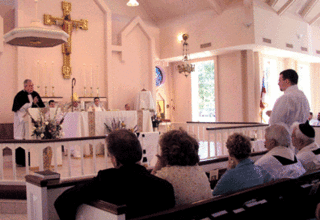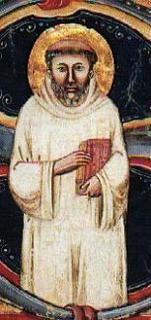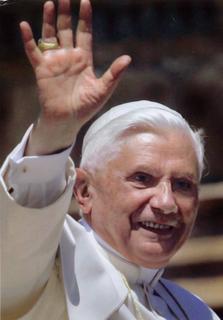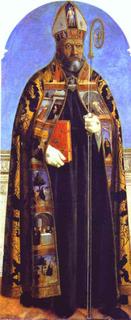
This sermon delivered at St. Vincent's Cathedral Church, Bedford, Texas, on August 15, 2005:
The Church of Holy Wisdom was the crown jewel of Constantinople, the largest and grandest worship space in Christendom, and that evening it was packed with the faithful: men and women, young and old, soldiers and civilians—and most amazing of all, both eastern Orthodox and western Catholic Christians worshipping together for the first time in four hundred years. For centuries the armies of Islam had battered the Christian empire of Byzantium, inflicting defeat after defeat. Now the armies of the Sultan had the capital completely surrounded. What remained of the united Christian army of Byzantine troops and volunteers from Western Europe gathered to partake of our Lord’s precious Body and Blood one last time. It was the 28th of May 1453, and the Turks were at the city’s walls preparing a final assault. Everyone knew the fate of Constantinople would be sealed in the next few hours. They were making their peace with God.
After confessing their sins and sharing in the Blessed Sacrament, the city’s defenders processed out to take their place on the walls. But near the main gate, the army stopped to pray one last time in front of Constantinople’s holiest icon—the Hodigetria, “the Indicator of the Way.” For most of the last thousand years this image of Madonna and Child, believed to have been painted by St. Luke the Evangelist himself, had watched over those who came and went from the imperial city. The Akathistos, an ancient hymn praising the Blessed Virgin Mary, rang out from the troops gathered before the sacred image, their voices filling the streets: “Hail, you through whom Joy will shine forth! … Hail, you who carries Him who carries all! … Hail, you through whom the Creator becomes a Baby!” By dawn, most of the warriors who sang this hymn would perish. Their city would be in ruins.
For me the devotions of that final night in Constantinople exemplify the high esteem in which the medieval Church held the Blessed Virgin Mary. These men knew with virtual certainty that they would not see another sundown. They were engaged in a life-or-death struggle to preserve their culture and—as they saw it, the Christian faith—from annihilation. No doubt many thoughts went through their minds as they prepared to defend the walls. But almost to a man they chose to spend their last hours on earth worshipping the Living God and honoring to the mother of Christ. Why? What was it about the Virgin Mary that inspired such devotion?
Mary had, of course, been there from the beginning. When she freely chose to bear the Lord of creation in her own flesh, this young Jewish girl from Nazareth entered into a more intimate relationship with God than any human being had ever known. For a thousand years the Holy of Holies in the Temple had been the quintessential meeting place of the human and the Divine, but from the moment Mary uttered those fateful words, “Let it be to me according to thy word,” the spiritual landscape of the Universe had changed. Now God and Man actually became One within the Virgin’s womb. By God’s gracious will, Mary was able to give her Son the genuine humanity that would bear our sins on the cross and conquer death at the empty tomb. An indissoluble bond was forged between the mother and her divine Son, a bond so powerful that the nails that tore through Christ’s hands and feet on Calvary also pierced Mary’s soul like a sword. And yet as painful as watching her Son suffer on the cross must have been, Mary did not dissert him as so many disciples had. She remained at the foot of His cross alongside John, the disciple whom He loved.
“"Woman, behold, your son!" Jesus told to his mother as the end drew near. “Behold, your mother,” Christ implored St. John with His final breaths. A new family was born that hour at Calvary, when the apostle took Mary into his own home. And through the sacred Blood that was shed on that Judean hillside so long ago that family has today grown to countless millions. As you and I became children of our Father God by faith in His Son and the waters of baptism, we received an awesome Spirit of Adoption. Jesus Christ, the King of creation, became our Brother. And being our Brother, Christ wants to share His mother with us just as He did with St. John. Christ intends His Church to be one enormous, grace-filled, loving family. A hundred generations of Christians have looked to the Virgin Mary as the mother of that family.
That, of course, is what motivated the outpouring of love and devotion to the Blessed Virgin in Constantinople on that solemn night. Men who were about to offer the last, full measure of devotion for their country, their families, and their God opened their hearts and sang. They sang praises to their Creator and Redeemer, handing their souls over to Him as they prepared to enter eternity. And not surprisingly they turned to St. Mary, who was in a very real sense their mother, telling her of their love and their fears. They wanted to be comforted by her presence and her prayers, just as our Lord Jesus had undoubtedly been as a boy in Nazareth. Marian devotion is not primarily a matter of the intellect. It springs from deep in the heart. It is the Church as family, sons and daughters reaching out for Mary’s motherly embrace.
Of course, one must be careful to keep things in proper perspective. We must not allow anything to stand in the way of developing a close personal relationship with our Lord Jesus Himself. Some Christians in the past, for example, incorrectly perceived Christ as little more than a distant and pitiless Judge. They dared not approach such a dreadful Christ with their fears and their hopes but instead cultivated a relationship with kind and caring Mother Mary, trusting that her tender heart would receive their prayers and present them before the throne of Glory on their behalf. Surely even the Judge of Doomsday would listen to His Mother, wouldn’t He? This misguided theology promotes a flowering of devotion to St. Mary, but it also warps our relationship with the One who died for us and rose again--the One who is at once both our sovereign Lord and our loving Brother.
Of course, St. Mary would never wish to distract Christians from their devotion to Jesus. Nowhere in Holy Scripture does Mary vaunt herself. In fact, she is clearly uncomfortable when others call attention to the special grace God has conferred upon her. When the archangel Gabriel greets her at Nazareth with the title “Favored One,” for example, Mary is “greatly troubled at this saying.” In humility, she sees herself as nothing more than “the handmaid of the Lord,” or to put it more plainly, “the Lord’s servant girl.” After St. Elizabeth expresses wonder at receiving a visit from the “mother of my Lord” and prophesies that Mary is “blessed among women,” the Virgin responds by turning the attention away from herself and onto “God her Savior,” who “has regarded the low estate of his handmaiden” and “done great things” for her. Even when she acknowledges in her great hymn of praise that “all generations” will call her blessed, Mary takes no credit for herself. “Pay no attention to me,” she seems to say, “Look to the One who ‘exalts those of low degree,’ the God of Israel.”
The ancient icon before which the defenders of Constantinople stopped to pray that night was called “the Indicator of the Way” for good reason. It perfectly captured the humility of “the Lord’s servant girl” in wood and paint. The mother of our Lord looks out at the believer, cradling the infant Christ in her left arm. With her right hand Mary gestures to our Savior, who is the only Way to salvation. Her eyes seem to plead with us to turn our attention not to her, but to the One who is both her Son and her Lord. The image of mother and Child forms a unity, but it is a unity centered on Christ Jesus. This icon reminds us that we cannot see Christ for who He is in reality—truly human and truly divine—until we see His mother, the source of His humanity and first witness to His divinity. But St. Mary does not want us to fix our gaze on her. Her soul, indeed everything about her, wishes only to magnify our Lord.
The great Marian feast we celebrate tonight arose in late antiquity. It commemorates the Blessed Virgin’s entry into eternal glory after a life of faithful service to God. An ancient Tradition of the Church tells us that Mary received one final grace from God when her time on earth was complete: God gathered her to Himself in the fullness of her being, both body and soul, so that she might abide in glory with the One who is her Son and her Savior. During her lifetime, Mary had served as a sign of God’s “mercy on those who fear him from generation to generation.” By this final mystery she becomes a sign of hope for all humanity. Mary now participates forever in the kind of intimate fellowship with God that all the redeemed await with eager longing, body and soul enveloped in His Love.
Sacred Tradition does not tell us exactly how or where the “assumption” or “falling asleep” of Our Lady took place, and the Scriptures do not speak of it. The ancient and medieval Church considered this final blessing upon Mary to be a mystery beyond human comprehension and made no effort to explain exactly how someone’s body could be taken into Heaven. We are clearly not meant to understand the “mechanics” of Mary’s passing into the arms of her Creator and Redeemer.
To my knowledge, no church anywhere in the world has ever claimed to possess the Virgin Mary’s mortal remains. Considering the mania for collecting the relics of even little-known saints that gripped Europe in the Middle Ages, this is an astonishing fact. One would have expected bits and pieces of Mary to be scattered all over Christendom, becoming objects of great veneration with towering cathedrals built around them. There are no such relics. But isn’t it somehow fitting that we cannot even pay our respects at the grave of St. Mary the Virgin? The Lord’s servant girl who turned praise away from herself and offered it to the Savior God of Israel--the mother who even now directs our gaze away from herself and points us toward her Son—I doubt that Mary would want to be the center of that much attention. She sounds rather like some other mothers I know. “Oh, don’t trouble yourself about me. Now, have I told you about my Son? He’s simply wonderful. Please let me introduce you.”
Holy Mary, Mother of God, pray for us sinners, now and at the hour of our death. In the name of the Father, and of the Son, and of the Holy Spirit. Amen.















